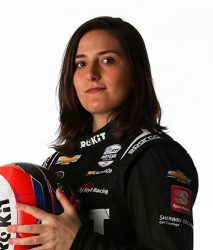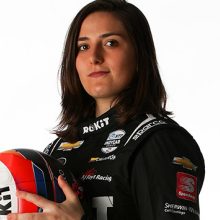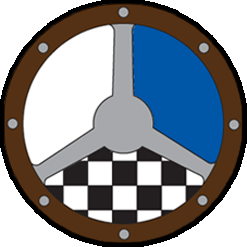Ask a pro
Receive advice directly from today’s top stars


Tatiana Calderón
IndyCar Driver AJ Foyt Racing
Tatiana Calderón is an IndyCar driver currently racing for AJ Foyt Racing, having previously been test and reserve driver for the Alfa Romeo F1 team and driver for Richard Mille Racing Team. Calderón was part of the first all-female driver lineup to compete in Le Mans this year with Richard Mille Racing Team, finishing 13th overall.
Her journey follows a successful career karting in Columbia and North America, where she became the first woman to be a champion of a national American karting series in 2008.
After strong seasons in Euro F3 and Formula Renault 2.0 she moved up to the F1 support bill to compete in GP3 series in 2016 and then subsequently Formula 2 in 2019.
In 2017 she tested an F1 car for the first time after being signed as a development driver for Sauber, going on to be named as the official test and reserve driver for Alfa Romeo for the 2018, 2019, and 2020 F1 seasons.
In 2022 she signed with AJ Foyt Racing to compete in 12 races in the IndyCar series this year, after the team expanded entry to three cars.
Tatiana Calderón answers your questions!
-
Ian Craig
Who was your racing idol growing up?




I grew up watching Juan Pablo Montoya racing in IndyCar and in Formula 1, so he was definitely my idol and the one to follow. He inspired me to follow my dreams to reach Formula 1.
-
Chris Sharp
How are you finding Super Formula and the differences between that and Formula 2?




To be honest I am impressed with the downforce and general grip of the Super Formula car. Cornering speed is much quicker than the F2. It’s also a bit more powerful in terms of engine power. We use Yokohama tyres which require a very different style to Pirelli so I am still getting used to that actually. The Super Formula is only 8s slower then F1 in a circuit like Suzuka so it’s the perfect preparation and very enjoyable to drive.
-
Patrick Newman
Having tested a Formula E car, what is the biggest difference between that and an F1 or LMP2 car?




It’s so different! The power application and instant acceleration of FE is actually pretty impressive but you haven’t got much downforce and car is pretty heavy, tires are very different as well and it’s all about managing well your energy. It’s very complex and very different style of driving between them. I have been lucky to have experience them all.
-
Dylan Avery
Going into your first Le Mans with an all-rookie team, what were the main challenges?




Probably not having enough track time before the race. We had less practice then usual due to COVID and instead of being able to drive weeks before we only had one day and when you have to share the car with two other drivers at the end there is not much track time. Also driving at night was difficult because you get reflections everywhere and is difficult to focus at the beginning, then your eyes get used to it and is ok. Also the traffic was not easy and I think as rookies is where we lost more time.
-
Gino Thompson
How do you achieve the optimum gear shifts and not lose speed in a corner?




Usually you get some information from the engineers but the best thing is to try and be consistent with what you do. We have shift lights specifically for every gear to find the optimum rpms to shift up and not lose any speed. It’s pretty smooth but it requires a lot of focus and precision as if you miss a gear shift you can lose a lot of time.
-
Jeff Hamilton
How can drivers provide significant value to sponsors?




I think in many different ways and you can build each strategy according to the brand that sponsors you. For example you can easily promote brands in the automotive sector, because as a Driver you are considered an expert in the field. You can also opt for the classic marketing by putting stickers on the car, wearing the brand on the clothes so that it is visible in each interview you do so it has a wider reach. You can create events with them to reach more people and generate engagement with the brand, also social media is a great tool today.
On the other hand as an athlete you reflect and inspire certain values that is key they are aligned with the brands you are representing because then with the synergy everything works good.
-
Jack
Do you race in esports? How do you find it helps learn a track or car?




Not so much. During the quarantine I started to learn more about it, I even raced the virtual 24 hours of Le Mans and I really think it is a powerful tool for drivers. I don’t really like to compete because I also think is very different than racing, but I do believe it plays a big role today for drivers as track time is very limited. It helps you understand a lot of things, is great to work with the engineers and to learn the tracks of course.
-
Steven Sawicki
What can be done to encourage more women to enter motorsports and what can be done to see that there are more opportunities for those who wish to become involved?




I think the problem comes from the bottom of the pyramid – we don’t have enough girls at karting so it means we will have less girls at the top of motorsport and that is related to the perceptions we have. Parents need to believe it is also a sport for girls and take not only the boys to karting but also the girls. They also need to see more women on the series like F1 that have worldwide coverage to believe it is possible and for that we need to have the right opportunities, which is still difficult. The FIA has been working a lot on generating those opportunities for Women in the sport. Two great examples from this year, the program in the LMP2 car with the Richard Mille Racing Team and the Rising Star program that will support one girl to be part of the Ferrari Driver Academy.
-
George Smith
How often are you on a simulator, exercising, meeting with sponsors?




Almost every day. I train at least 6 days a week if I don’t have to travel. I try to do some simulator at home 2 or 3 times a week and I also do the professional simulator with the team prior to the races, especially for example this year as all racetracks were new to me in Japan. Meeting with sponsors also depends but could be many times during the year and if you have to record commercial take part in different events. Is always a non-stop.
-
Eddie Chamberlain
What is your favourite memory of racing?




Probably the first time I drove a Formula 1 car back in 2018 in Mexico. It was like a dream come true after working so hard so many years.
-
Pablo
What’s been your favourite race in the rain?




Probably the race at Spa while I was competing in the FIA F3 European Championship. We had to gamble as we started in the back and after one lap I was leading, good fights for the top positions, but it started to dry and only rained once the race was over but I had so much fun!
-
Brad
For a young driver who wants to race in Formula 2 or Super Formula, could you explain how they compare physically to a Formula 1 car?




Well both series have a very quick car, so is definitely a good preparation. The Super Formula car has more downforce, similar to the F1, so the corner speed is closer than with the F2 car, but in Japan they use Yokohama tyres instead of Pirelli so that changes a lot the way you have to drive. Also both Super Formula and F1 have power steering and are more demanding on the neck but F2 has no power steering so it’s also very physical.
-
Joseph Wahrer
I’m curious what would you like to see educators do to help encourage more girls to get involved in racing and motorsports?




I think this is a great point. We definitely have to encourage them to try motorsport as it is still perceived as a male dominated sport and most people don’t even know we can compete in the same championship. We need to show them it is possible for them to race or work in the motorsport field and we need also to educate the parents, to help change the perception and to bring the girls also to karting. That’s actually how I started.
-
Jake
What are the most common mistakes you see young drivers making? What would you say they need to improve on?




I think many drivers want to change championships as quickly as possible because they always feel ready for the next challenge and sometimes is better to race more than one year in the same series if you are not able to compete with a top team.
-
Jack
What is the biggest piece of advice you could give to a young driver coming up the ranks?




Patience is key!! Things will come at the right time. Work hard physically and mentally because all sports require you to do so. It is very demanding, and you need to be ready for when opportunities arrive.
 Road Racing Drivers Club
Road Racing Drivers Club
 Share
Share







